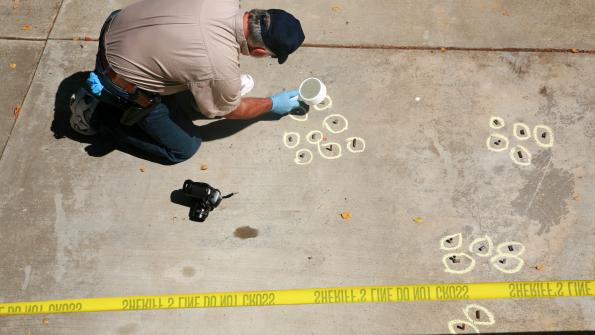Flint, Mich., named most dangerous city in America
24/7 Wall Street, a financial news and trends site, has released a list of the nation’s top 10 most dangerous cities compiled from Federal Bureau of Investigation data. Flint, Mich., for the third year in a row, has topped the list.
Data shows that after declining nationally for five consecutive years, violent crimes rose by 1.2 percent in 2012. The increase was even greater in some of America’s largest cities. Violent crimes, as defined by the FBI, include murder, non-negligent manslaughter, rape, robbery and aggravated assault. The top ten cities with the highest instances of such crimes, according to the report, are:
10. Cleveland, Ohio
Violent crimes per 100,000 – 1,383.8
Population – 393,781 Murders in 2012 – 84
Poverty rate – 34.3 percent
9. Baltimore, Md.
Violent crimes per 100,000 – 1,405.7
Population – 625,474
Murders in 2012 – 219
Poverty rate – 25.1 percent
8. New Haven, Conn.
Violent crimes per 100,000 – 1,439.2
Population – 129,934
Murders in 2012 – 17
Poverty rate – 30.1 percent
7. Birmingham, Ala.
Violent crimes per 100,000 – 1,517.8
Population – 213,266
Murders in 2012 – 67
Poverty rate – 32 percent
6. Stockton, Calif.
Violent crimes per 100,000 – 1,548.0
Population – 299,105
Murders in 2012 – 71
Poverty rate – 25.8 percent
5. Memphis, Tenn.
Violent Crimes per 100,000 – 1,750.0
Population – 657,436
Murders in 2012 – 133
Poverty rate – 27.2 percent
4. St. Louis, Mo.
Violent crimes per 100,000 – 1,776.5
Population – 318,667
Murders in 2012 – 113
Poverty rate – 27.0 percent
3. Oakland, Calif.
Violent crimes per 100,000 – 1,993.1
Population 399,487
Murders in 2012 – 126
Poverty rate – 21 percent
2. Detroit, Mich.
Violent crimes per 100,000 – 2,122.6
Population – 707,096
Murders in 2012 – 386
Poverty rate – 40.9 percent
1. Flint, Mich.
Violent Crimes per 100,000 – 2,729.5
Population – 101,632
Murders in 2012 – 63
Poverty rate – 40.6 percent
To combat Flint's growing crime problem, Genesee County Sheriff Robert J. Pickell proposed a plan to create a violent crime mobile task force, according to the report. However, Michigan Gov. Rick Snyder rejected the $3 million plan, saying the resources could be better used in the ongoing efforts to keep Flint safe.
The Detroit Free Press reports that the economies of most of these cities have been in decline for years, in some cases long before the Great Recession. John Roman, senior fellow at the Urban Institute, explained that, in addition to sluggish economies, the populations of most of these cities has declined in recent years, leaving behind impoverished urban centers. The loss of economic diversity, according to Roman, exacerbates crime in cities like Detroit, Flint, Cleveland, Ohio, and St. Louis, Mo.
All of the cities listed have poverty rates above the national average of 15.9 in 2011, according to the Detroit Free Press. In half of the cities, more than 30 percent of the population lives in poverty. In Detroit and Flint, the rate is more than 40 percent. “It is very clear that poverty in particular is associated with higher crime rates,” said Roman.
However, it is important to note that the relationship between poverty and crime is uncertain. The report does not show if high crime rates make a city poorer, or if poverty causes more crime.
Read the full report here.





















Poverty breeds crime, but
Poverty breeds crime, but also high crime does make a city
poorer. It’s a circular process. Poverty makes for a lack of
self-esteem that is taken to the streets in the form of criminal
activity and thinking patterns. People having to live in crime
ridden areas have also low self-esteem though they are not in-
volved in such behaviors. Their properties reflect the attitude and
perceived hopeless despair. This leads to further poverty. Unless
the city fathers take an active role in a real recovery program the
process gets deeper. This does not mean the city et al govern-
ment program comes in and just hands our gobs of money for
nothing in return. No, there has to be shown a bit of sensitivity
but also a motivational spirit to get residents to want to improve
their prospects. The old adage of “teaching a man to fish to feed
himself for life” applies here versus “giving him the fish to feed
himself for a day” which is too often the real case. Drive through
a poverty stricken area and note the squalor. Much of it can be
simply corrected by a property owner taking interest in just
picking up litter. This has to spread to others to have an immedi-
ate effect. Once this takes hold, other improvements can be
seen. It is not fast, but it does work – slowly. The city fathers can
take a more drastic approach and condemn properties and seize
& raze them, but that sends the miscreant portion of the popu-
lation into the next circle of urban geography. And so on the
process grows. Outside commercial entities have no interest in
locating in such cities. Likewise there is no attraction for a viable,
taxpaying workforce to move there. Again, the circular pattern
emerges. Difficult but not impossible to overcome.
just legalize weed. done..
just legalize weed. done.. end of story. Doubt it, look at denver..